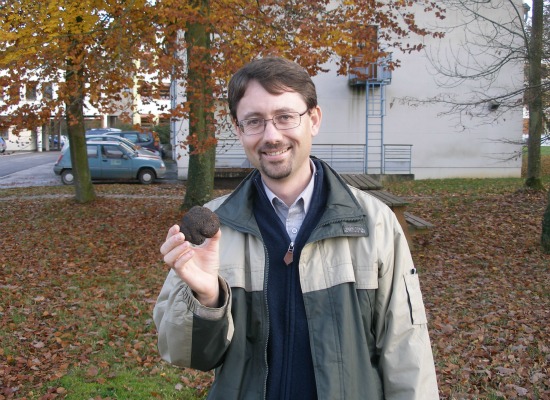Truffle Trouble in Europe: The Invader Without Flavor
If it looks like a black truffle, and if it cost you $1,500 a pound like a black truffle—-it may actually be a worthless Chinese truffle
/https://tf-cmsv2-smithsonianmag-media.s3.amazonaws.com/filer/20120515120029TRUFFLE_FRANCESMALL.jpg)
If it looks like a black truffle, and if it cost you $1,500 a pound like a black truffle—it may actually be a Chinese truffle.
That’s because fraudulent vendors here in France’s Périgord region, where I’m shacked up for a week in a village on the Dordogne River, sometimes sell lookalike truffles from China as the real thing, which is loved as an aromatic addition to meat, egg and pasta dishes. They mix the imported coal-colored nuggets, of the species Tuber indicum, into baskets of genuine Périgord black truffles, or Tuber melanosporum, and sprinkle them with cheap but aromatic truffle oil to fool buyers into handing over big bucks for the bland imposters.
It’s a fraud of which hunters and buyers are well aware. The landlord of our rental house, Jean Claude, is a truffle hunter. Each fall and winter, he slogs across his property through the mud, his dog Ceci leading the way as she sniffs out the treasures. Jean Claude says Chinese truffles find their way illicitly into local restaurants and markets. Other times, people buy them knowingly, paying about $100 for honestly labeled T. indicum, even though the mushrooms are essentially worthless. In Italy, the sale of Chinese truffles is illegal, even if they are legitimately labeled. By many opinions, the Chinese truffle has no rightful place in the realm of fine European cuisine—but its presence here is prominent. According to experts, between 20 and 30 tons of Chinese truffles are sold in Europe each year.
Recently the situation has gotten much worse: Chinese truffles have been found growing semi-wild in Italy. French truffle expert Claude Murat made this discovery in 2007, when he was working at the University of Torino. Murat received a call from a suspicious farmer in Italy’s Piedmont region in 2006 who explained that he had planted a grove of young hazelnut trees a decade before, believing them to be seeded with spores of T. melanosporum. Buying inoculated “truffle trees” from specialized nurseries is common among European landowners wishing to cultivate black truffles. But, 10 years after planting the trees, the man had not harvested a single truffle, and Murat, then in his post-doc years, came to investigate. What he found generated a quiet rumble of hysteria among truffle farmers and hunters and the moneyed foodies who buy, cook and eat the black truffle: Chinese truffle mycelium established among the roots of the farmer’s trees.
“We thought it might have been a mistake, so we tested it a second time and we found it was definitely Tuber indicum,” said Murat, now the engineer of research at the National Institute of Agronomic Research (INRA), in Champenoux.

Can you tell the Chinese from the French Périgord black truffle? Even Dr. Claude Murat, a truffle expert shown here with a Périgord black, says the two species are very difficult to tell apart---a big problem for dealers of the fragrant fungus. Photo courtesy of Claude Murat.
Murat says that lab tests conducted by him and his colleagues indicate that the Chinese truffle is a tougher, more adaptable species, more competitive and more tenacious, and when the two have been placed together in a controlled environment, T. indicum has won, he says. But the matter gets more serious than a simple one of habitat competition. T. indicum and T. melanosporum are genetically similar enough that the two can interbreed, posing the risk that the two species may merge into a hybrid that lacks the fetching attributes of the Périgord black. Moreover, the invasive species also has a wider range of genetic variability than the Périgord black, which could allow it to adapt dangerously well to a new habitat.
“There is the chance that Tuber indicum could replace Tuber melanosporum,” Murat said.
Already, T. melanosporum is undergoing tough times. For reasons uncertain, the annual harvest has declined from more than 1,200 tons in 1900 to less than 100 tons today. In the most recent winters, truffle hunters unearthed as little as 20 tons. Experts suspect that modification and disruption of the black truffle’s forest habitat is the main factor in the decline.
Murat says that in Piedmont, there are very few black truffle plantations from which Chinese truffles could spread across the landscape, and so far, T. indicum has not been found growing wild in Europe anywhere outside of the single Italian plantation.
“But if they get into a region in France, like the Périgord, where there are many truffle plantations, it could be a serious problem,” he said.
And for a taste of truffle trivia: The truffle oil that many of us keep in our cupboards (not all of us can afford truffles, okay?) and use to impress dinner dates is usually a product of exquisitely exacting chemistry labs, where experts have learned to duplicate the molecule 2,4-dithiapentane that produces the entrancing scent of wild truffles—especially the Italian white truffle, or Tuber magnatum. This lovely molecule—one of my personal favorites—occurs naturally in wild truffles. Some purists argue that test tube truffle oil is fake—but is it really? Because for my unwitting dinner guests, a whiff of that stuff takes them straight to the Périgord faster than a flight on Air France. Ignorance and truffle oil are bliss.
Planning Your Next Trip?
Explore great travel deals
Smithsonian magazine participates in affiliate link advertising programs. If you purchase an item through these links, we receive a commission.
/https://tf-cmsv2-smithsonianmag-media.s3.amazonaws.com/accounts/headshot/Off-Road-alastair-bland-240.jpg)
/https://tf-cmsv2-smithsonianmag-media.s3.amazonaws.com/accounts/headshot/Off-Road-alastair-bland-240.jpg)